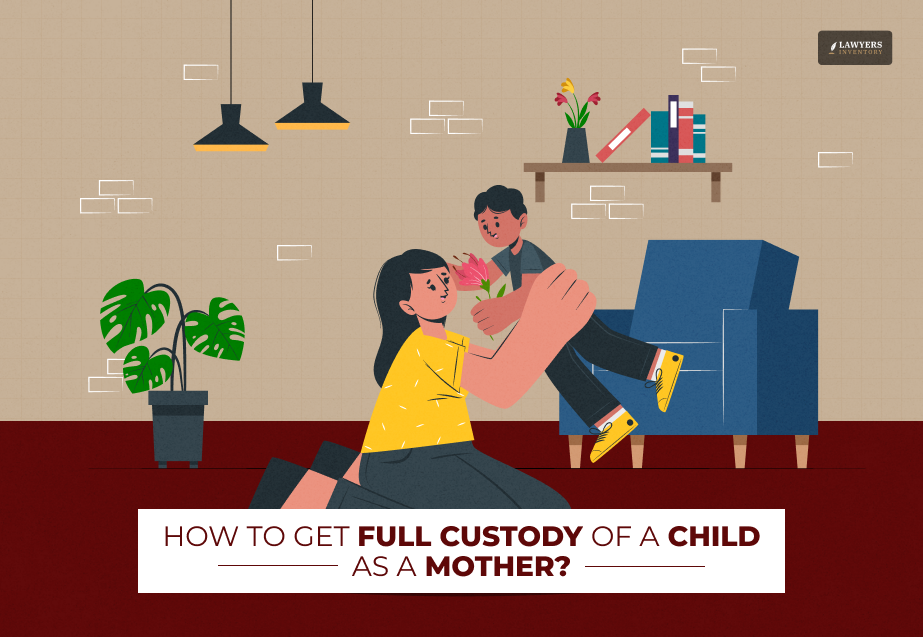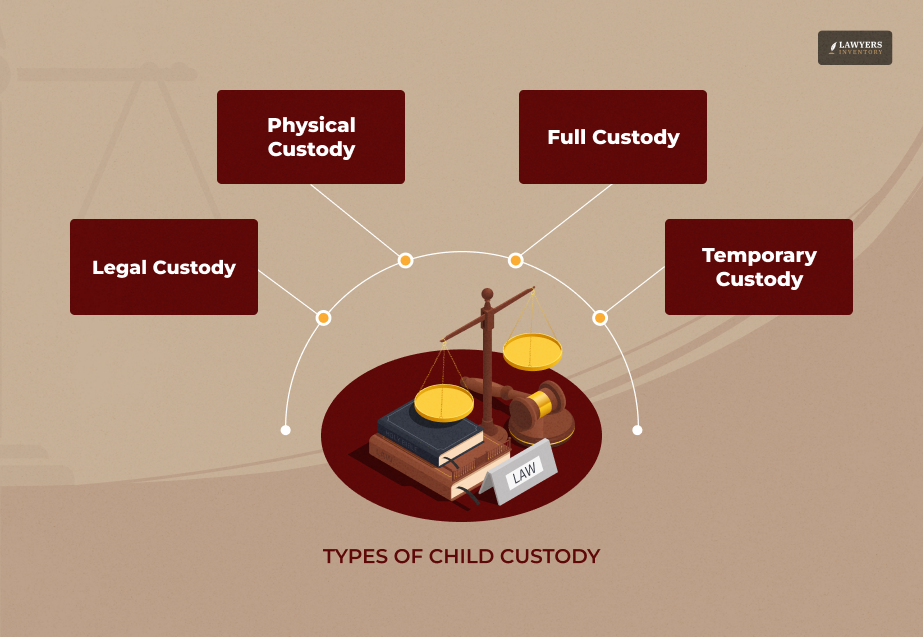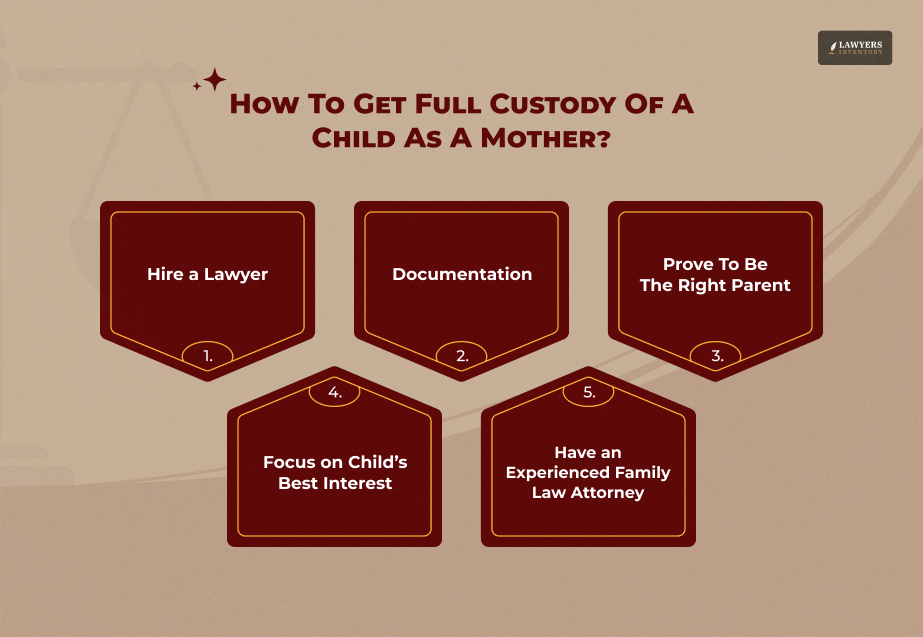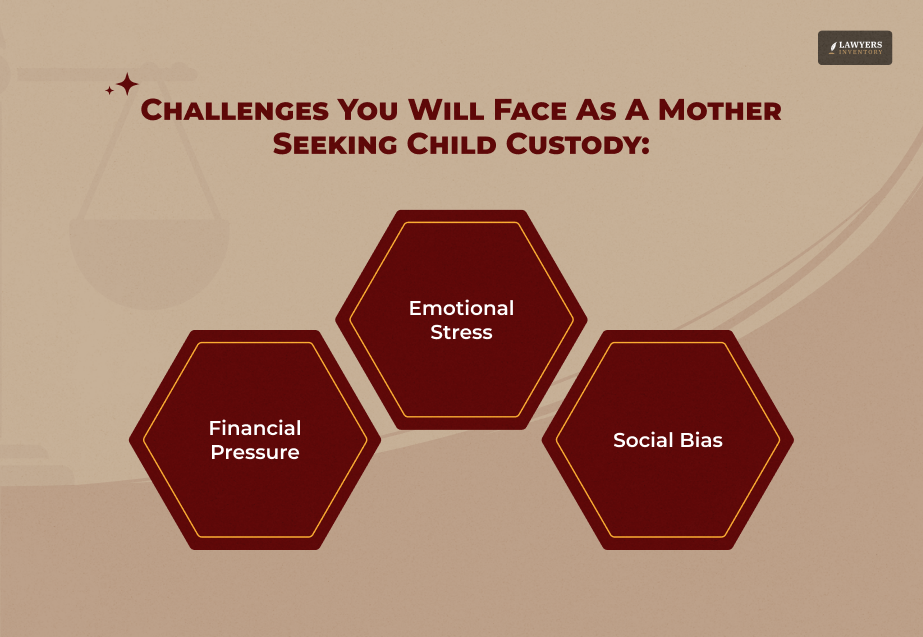
“How to get full custody of a child as a mother?” If this is something that you have been searching for, you have reached the right place!
If you are a mother considering seeking full custody of your child, it’s natural to feel overwhelmed. You might have questions like, “What steps should I take?” or “How do courts decide custody?”
The process may seem complicated, but understanding your rights and responsibilities can make a huge difference.
Full custody, also known as sole custody, gives one parent the legal right to make decisions for the child while also being their primary caregiver. Courts typically prefer joint custody to ensure the child has a balanced relationship with both parents.
However, there are situations where full custody becomes necessary—such as cases involving neglect, abuse, or an unfit parent.
In this article, I will break down the process into simple, clear steps backed by expert insights. Additionally, I will also explain how you, as a mother, can build a strong case to show the court that full custody is in your child’s best interest.
From gathering evidence to working with legal professionals, I will try my best to guide you through the key aspects you need to know.
Understanding Different Types of Child Custody

When it comes to child custody, it’s important to understand the different types so you know exactly what you’re asking for in court.
Custody laws can vary slightly depending on the state you live in, but generally, child custody falls into two main categories: legal custody and physical custody.
Legal custody refers to the right to make major decisions about your child’s life. This includes choices about their education, healthcare, religious upbringing, and general well-being.
Legal custody can be joint, where both parents share decision-making responsibilities, or sole, where one parent has the full authority to make these decisions without needing input from the other parent.
Physical custody, on the other hand, determines where the child will live and who will be responsible for their day-to-day care.
Like legal custody, it can also be joint or sole. In joint physical custody, the child spends time living with both parents. In sole physical custody, the child lives with one parent full-time, while the other parent may have visitation rights.
There’s also temporary custody in some cases, which is granted during the divorce or custody proceedings. It’s meant to provide a stable arrangement for the child until the court makes a final decision.
Courts aim to act in the child’s best interest when determining custody, often favoring arrangements that allow both parents to stay involved.
However, when circumstances demand, courts can award one parent full custody. This brings us to the next important question: what exactly is full custody?
What is Full Custody?
Full custody, often referred to as sole custody, is when one parent has both legal and physical custody of the child.
This means that as the mother if you are granted full custody, you would have the exclusive right to make all major decisions about your child’s life.
Additionally, your child would live with you full-time, and you would be their primary caregiver.
In most cases, the other parent (the non-custodial parent) may still have visitation rights unless the court decides that their involvement could harm the child.
For example, visitation may be restricted or supervised in situations where there’s a history of abuse, neglect, or substance abuse.
It’s important to note that courts don’t grant full custody easily. Judges typically believe that children benefit from having a relationship with both parents.
Therefore, the parent seeking full custody must prove that this arrangement is truly in the child’s best interest, similar to a guardianship agreement.
For a mother to successfully gain full custody, she needs to provide strong evidence. This can include proof of the other parent’s inability to care for the child, instances of abuse, or situations where the other parent is absent or unreliable.
Documentation like police reports, medical records, school reports, and witness statements can play a critical role in strengthening your case.
Having full custody comes with significant responsibilities. As the sole custodian, you will be entirely responsible for your child’s physical, emotional, and financial needs.
You’ll need to ensure their stability, safety, and well-being at all times. While this can feel overwhelming, many mothers pursue full custody because they believe it’s the best way to protect and support their children.
Custody Statistics in the USA Right Now
Child custody battles are more common than ever, and the statistics reveal some important trends that every mother seeking full custody should know. According to recent studies, approximately 80% of custodial parents in the United States are mothers.
This figure shows that while mothers in a single-parent family are often favored in custody arrangements, courts increasingly strive for fairness. It focuses on the child’s best interests rather than gender bias.
Joint custody has become more popular in recent years as courts recognize the importance of both parents being involved in the child’s life.
However, sole custody—where one parent has both legal and physical custody—is still granted when circumstances call for it.
For instance, in cases involving neglect, abuse, or an absent parent, courts are more likely to award full custody to one parent, usually the mother.
The same data also highlights that custodial mothers receive child support more often than fathers.
In fact, around 45% of mothers with sole custody receive financial support for their children. This reinforces the fact that mothers who win full custody often carry the majority of the financial and emotional responsibilities for their children.
While these statistics offer some reassurance, they also emphasize the need for mothers to prepare thoroughly when seeking full custody.
Understanding the legal process, the challenges involved, and the factors courts consider can make a significant difference.
How to Get Full Custody of a Child as a Mother?

Winning full custody as a mother requires careful planning, strong evidence, and a clear understanding of the legal process.
Courts don’t make these decisions lightly, so it’s important to demonstrate that full custody is truly in the child’s best interests.
Here’s how you can approach this process effectively:
1. Hire an Experienced Family Law Attorney
The first step is to consult with a skilled family law attorney who has experience handling child custody cases. A good lawyer will guide you through the legal process, help you gather evidence, and present your case in the most compelling way possible.
2. Document Everything
Strong evidence is key to winning full custody. Keep a detailed record of all interactions with the other parent, especially if they are unreliable, neglectful, or abusive. Save text messages, emails, and voicemails that demonstrate their behavior. Collect any police reports, medical records, or witness statements that support your case.
3. Prove You Are the Better Parent
You need to show the court that you can provide a stable, loving, and safe environment for your child. This includes demonstrating your ability to meet your child’s needs—emotionally, physically, and financially. Highlight factors like your involvement in your child’s education, healthcare, and extracurricular activities.
4. Focus on Your Child’s Best Interests
The court’s top priority is always the child’s well-being. Be prepared to explain why full custody is best for your child. Avoid badmouthing the other parent—focus instead on why your home environment will ensure the child’s safety, stability, and happiness.
Challenges Mothers Might Face

While mothers often assume they have an advantage in custody cases, that’s not always true. Courts are becoming increasingly neutral, which means you’ll need to provide solid evidence. Here are some common challenges you might face:
- Proving the Other Parent Is Unfit: You may face difficulties proving neglect, abuse, or instability if there’s limited evidence.
- Financial Pressures: Legal battles can be expensive, and the process may take a toll on your financial situation.
- Emotional Stress: Custody disputes can be emotionally draining, especially when the other parent fights back aggressively.
- Bias or Misconceptions: While rare, some courts may question whether you can provide for the child on your own, particularly if the other parent has greater financial resources.
Despite these challenges, being prepared and staying focused on your child’s needs can help you overcome them.
Factors Courts Consider for Full Custody
To decide custody, courts consider a variety of factors, all aimed at ensuring the child’s well-being. Understanding these factors and preparing a strong case with the help of your attorney can significantly increase your chances of getting full custody.
Here are the most important elements:
- The Child’s Safety and Well-Being: The court will assess whether either parent poses a risk to the child due to neglect, abuse, or substance abuse.
- The Parent-Child Relationship: Courts look at which parent has been the primary caregiver and who has a closer emotional bond with the child.
- The Child’s Needs: The child’s physical, emotional, and educational needs play a significant role in custody decisions.
- Parental Stability: The court evaluates each parent’s ability to provide a stable home environment. Consistency, financial stability, and a clean-living space matter.
- Parental Fitness: Any history of criminal activity, mental health concerns, or substance abuse can affect the court’s decision.
- The Child’s Preference: In some cases, if the child is old enough (usually 12 years or older), their preference may be taken into account.
- Co-Parenting Efforts: Courts appreciate parents who are willing to encourage a relationship between the child and the other parent unless doing so would harm the child.
Legal Rights of Mothers in Child Custody Cases
When it comes to child custody cases, mothers have the same legal rights as fathers. Courts no longer favor one parent over the other based on gender alone. Instead, they focus on what is in the best interest of the child. As a mother, it’s important to understand your rights so you can navigate the legal process with confidence.
First, you have the right to seek legal custody (the ability to make important decisions about your child’s life) and physical custody (where the child primarily lives).
You can request joint custody to share responsibilities with the other parent or full custody if you believe it’s necessary for your child’s well-being.
If the father is absent, unfit, or poses a danger, you have the right to present evidence to support your case for full custody.
Courts will consider factors like your child’s safety, emotional stability, and ability to provide a nurturing environment.
Additionally, you have the right to request child support if you are awarded full custody. This financial assistance can help you meet your child’s needs.
Read Also:
- How to Prepare for a Child Support Hearing?
- Online Child Abuse Cases: The Crucial Role Of A Lawyer
- Child Identity Theft is Increasing! What Parents MUST Do [Experts Advice!]










0 Reply
No comments yet.